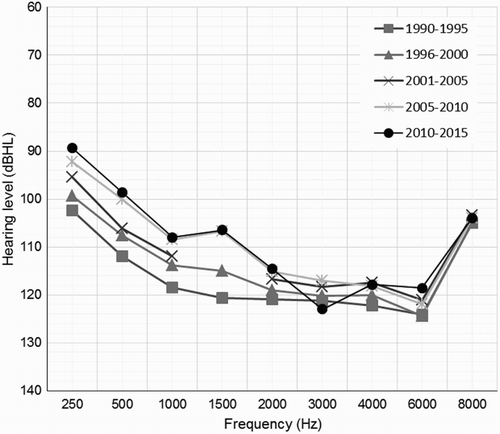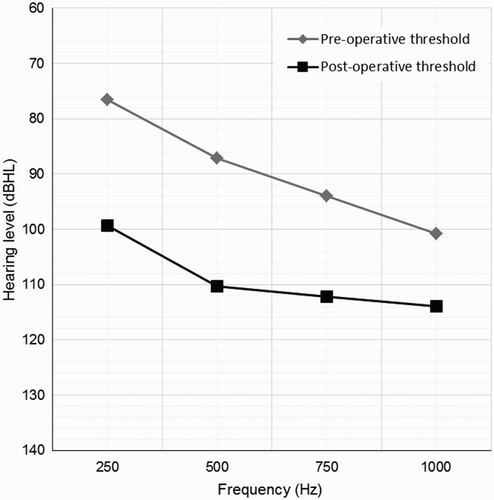Abstract
Introduction: A retrospective evaluation of pre- and post-operative audiometric data at a single large UK cochlear implant centre over 25 years was undertaken.
Methods: Analysis of pre-operative hearing levels showed that there was a modest but significant reduction in average pre-operative hearing thresholds among patients referred between 1990 and 2015, particularly in the low frequencies.
Outcomes: The proportion of those referred who would meet widely-accepted candidacy criteria for electro-acoustic stimulation (EAS) grew significantly over time but in the period 2011-2015 just 9% of those referred had sufficient residual hearing for EAS. On average, implant recipients lost 20 dB hearing at frequencies ≤1000 Hz as a result of the surgery.
Conclusions: The findings suggest that hearing preservation is now widely achievable, and that both candidacy criteria and referrer education should take into account potential EAS benefit.
Introduction
Electro-acoustic stimulation (EAS) refers to the combination of acoustic amplification through a hearing aid and electrical hearing through a cochlear implant (CI) in the same ear (CitationHelbig et al., 2011). CI recipients can achieve greater benefit from EAS compared to electrical stimulation through a CI on its own, provided that adequate low frequency hearing is preserved post-operatively (CitationGifford et al., 2013; CitationTalbot & Hartley, 2008). Benefits include improved perception of music, pitch perception, listening in background noise, and speech perception more generally (CitationIrving et al., 2014). The evidence review for CI candidacy that informed NICE guidelines issued in 2009 (CitationNICE, 2009) was not specifically designed to take account of hearing preservation and potential for EAS benefit, although the absence of low frequency thresholds from candidacy guidelines does, in theory, allow for EAS. However, in practice, many adults who could benefit from EAS may demonstrate BKB sentence recognition scores at or above 50%. It has been suggested that as many as 900 000 individuals within the UK alone could benefit from cochlear implantation (CitationAction on Hearing Loss, 2011) of whom potentially a large proportion could benefit from EAS.
Maximizing potential EAS benefit in the wider population requires both that potential EAS recipients are referred for assessment and also that adequate post-operative hearing preservation is achieved. In order to investigate these two areas, we report a retrospective service evaluation of hearing preservation outcomes at the University of Southampton Auditory Implant Service (USAIS), a large NHS-funded cochlear implant centre in the UK with over 1000 CI recipients as of 2015. Audiometric data were interrogated to determine whether individuals who might benefit from EAS are being referred and whether referral trends over time reflect greater awareness of benefits for those with better low frequency hearing (e.g. available thresholds at octave frequencies below 1000 Hz), and the extent of hearing preservation across service users. Current EAS devices are able to provide sufficient gain to meet prescription targets for hearing loss up to approximately 80 dB HL. Therefore, post-operative hearing levels of 80 dB HL or better in the low frequency region are needed to support effective EAS stimulation. In the present study we defined those who might benefit from EAS in two-ways-first, those with an average pre-operative hearing threshold of 65 dB HL or better at 250 and 500 Hz (the criterion currently recommended by manufacturers and widely reported in the literature, for example CitationIrving et al. 2014), and those with 80 dB HL or better at the same frequencies.
Methods
Pure tone audiometric (PTA) data on all patients who had attended USAIS since its inception in 1990 were first interrogated in order to determine the extent of pre-operative unaided hearing, and to find out whether there had been a trend over time for those with greater degrees of (especially low frequency) residual hearing to be referred to the centre. University of Southampton ethical approval was granted for the service evaluation. Data were extracted from the centre's clinical database for further analysis using IBM SPSS Statistics version 22. All unaided pre-operative air-conduction audiograms were included, so long as they were expressed in terms dB HL (irrespective of transducer, e.g. whether insert earphone, headphone or loudspeaker), in order to allow comparability between individuals. Mean audiometric thresholds were grouped into 5-year intervals from the inception of USAIS in 1990 until July 2015 and statistical and descriptive comparisons were made between pre-operative low frequency thresholds across the different intervals. To analyse post-operative loss of residual hearing, all available post-operative audiograms were interrogated and compared with corresponding pre-operative audiograms.
Results
Figure shows pre-operative unaided pure tone audiograms over 5-year intervals since the inception of USAIS in 1990 (n = 941 ears). This shows a slow increase in low frequency hearing thresholds over time, although it is notable that unaided hearing in the low frequencies in even the most recent 5-year block (2011–2015) is still within the profound category. Table shows the absolute number and proportion of ears which could be deemed potentially suitable for EAS using the more or less strict criteria proposed above. Although this shows a trend for an increasing proportion of implant candidates being referred with useable low frequency residual hearing, the total proportion of those who might benefit from EAS in the most recent cohort was still just 8.7% (using the stricter EAS criterion). The Z-test for proportions-independent groups based on 95% confidence interval showed that there was a significantly greater proportion of referred candidates who met the 80 dB candidacy criteria in 2011–2015 compared to all previous year groups, and a significantly larger proportion meeting 65 dB candidacy criteria in all other year groups except 2006–2010.
Figure 1 Unaided pure tone audiometric thresholds by air-conduction in 5 year blocks for individual ears for all cochlear implant candidates referred to the University of Southampton Auditory Implant Service who were subsequently implanted.

Table 1 Number and percentage of individual ears meeting two different EAS candidacy criteria among in 5 year blocks for all cochlear implant candidates referred to the University of Southampton Auditory Implant Service who were subsequently implanted
A one-way analysis of variance was undertaken to compare the mean threshold at 250 and 500 Hz across the 5 year groups. The analysis yielded a significant overall effect of group (F(4, 762) = 8.49; P < 0.001). Post hoc comparisons using Bonferroni correction showed that threshold averaged across 250 and 500 Hz was significantly better in the 2011–15 year group as compared to all other year groups, and that thresholds were also significantly worse with the oldest year group (1990–95) compared to the 2006–2010 year group, while no other comparisons were significant.
Figure shows the mean pre- and post-operative air-conduction pure tone audiogram across all patients for whom post-operative unaided air-conduction audiometric data were available (n = 105 ears). The number of available data points for this analysis was lower than for the referral analysis due to the fact that routine post-operative unaided hearing testing was only introduced in 2012. In most cases, only one post-operative audiogram was available, with timings varying between one month after implantation (at initial tuning) and six months post-implantation. The comparison is therefore between the latest available pre-operative audiogram and the latest available post-operative audiogram (e.g. if more than one available). This shows a mean post-operative hearing loss of 23 dB at 250 and 500 Hz, 18 dB at 750 Hz, and 13 dB at 1000 Hz. The average loss of hearing across all four frequencies was 19 dB, although the average across 250, 500, and 1000 Hz (e.g. excluding 750 Hz, which was unavailable in most cases) was 20 dB. A two-way analysis of variance with two factors of frequency and pre- vs. post-op showed a significant overall effect for frequency (F(3, 621) = 37.5; P < 0.001) and the pre/post-op factor (F(1,2 07) = 165.8; P < 0.01) as well as a significant two-way interaction (F (3, 621)= 37.5; P < 0.001). Post hoc analysis showed that all pre- vs. post-operative comparisons were significant for individual frequencies, and the interaction was due to the greater magnitude of effect at lower compared to higher frequencies.
Discussion
Among CI candidates and recipients in a large UK cochlear implant centre, mean loss of residual hearing up to 1000 Hz after implantation is around 20 dB. Although this is a clinically and statistically significant loss of hearing across frequencies, the degree of hearing loss is comparable with published studies with smaller, more controlled cohorts of specific hearing preservation protocols (CitationSkarzynski et al., 2013). This suggests that hearing preservation is achievable in current NHS clinical practice, is sufficiently good to support EAS in a large number of recipients, and that the potential to benefit from EAS should be considered. CitationGifford et al. (2013) has suggested that the increase in benefit for those using EAS stimulation can be as much as +2 dB signal-to-noise while other studies have shown as much as 50% increase in speech recognition scores as compared to cochlear implantation alone (CitationBrown & Bacon, 2009).
The current analysis also found that the average pre-operative audiogram of those referred for CI assessment has changed relatively slowly (albeit significantly) over time, with a mean pre-operative hearing loss at 250 and 500 Hz of worse than 90 dB HL even in the current decade. The proportion of those who might benefit from EAS using more conservative and widely used candidacy criteria even in the most recent 5-year period was still only 9%. Our results, taken in combination with the likely prevalence of those with severe/profound high frequency loss but better low frequency loss, may indicate that the UK is still seeing under-referral of potential EAS candidates, based on widely accepted criteria of 65 dB HL hearing in low frequencies. If so, this could be addressed by raising a greater awareness among referrers and other stakeholders about the potential benefits from EAS and the need to refer those who meet EAS candidacy criteria, and to determine if there are specific barriers to referral (such as beliefs about likelihood of hearing loss after implantation, or the inclusion of BKB test results in adult CI candidacy criteria).
Conclusion
Hearing preservation outcomes within a large UK cochlear implant centre are comparable with those from published studies and are achieved in a variety of patient sub-groups. The potential for greater benefit from EAS compared to CI alone in those with adequate pre-operative residual hearing should be taken into account in public and referrer awareness, referral guidelines and CI candidacy criteria.
Disclaimer statements
Contributors None.
Funding None.
Conflicts of interest None.
Ethics approval None.
References
- Action on Hearing Loss. 2011. Hearing matters.
- Brown, C.A., Bacon, S.P. 2009. Achieving electric-acoustic benefit with a modulated tone. Ear and hearing, 30(5): 489–493. doi: 10.1097/AUD.0b013e3181ab2b87
- Gifford, R.H., Dorman, M. F., Skarzynski, H., Lorens, A., Polak, M., Driscoll, C.L. et al. 2013. Cochlear implantation with hearing preservation yields significant benefit for speech recognition in complex listening environments. Ear and hearing, 34(4): 413–425. doi: 10.1097/AUD.0b013e31827e8163
- Helbig, S., Van de Heyning, P., Kiefer, J., Baumann, U., KleinePunte, A., Brockmeier, H. et al. 2011. Combined electric acoustic stimulation with the PULSARCI(100) implant system using the FLEX(EAS) electrode array. Acta oto-laryngologica, 131(6): 585–595. doi: 10.3109/00016489.2010.544327
- Irving, S., Gillespie, L., Richardson, R., Rowe, D., Fallon, J. B., Wise, A. K. 2014. Electroacoustic stimulation: now and into the future. BioMed research international, 2014, p.350504
- National Institute for Health and Care Excellence Technology Appraisal Guidance. 2009. Cochlear implants for children and adults with severe to profound deafness. NICE technology appraisal guidance [TAG166]. [accessed 29 January 2016]. Available from: http://www.nice.org.uk/ta166.
- Skarzynski, H., van de Heyning, P., Agrawal, S., Arauz, S. L., Atlas, M., Baumgartner, W. et al. 2013. Towards a consensus on a hearing preservation classification system. Acta oto-laryngologica, Supplementum, 133(564): 3–13. doi: 10.3109/00016489.2013.869059
- Talbot, K.N., Hartley, D.E.H. 2008. Combined electro-acoustic stimulation: a beneficial union? Clinical Otolaryngology, 33(6): 536–545. doi: 10.1111/j.1749-4486.2008.01822.x


